Disclosure: This post may contain affiliate links, meaning I get a commission if you decide to make a purchase through my links, at no extra cost to you.

A Jigsaw is not really known for cutting large dimensions of lumber. A Jigsaw is more associated with cutting tight corners, doing plunge cuts into plywood sheets, and creating rough saw marks with tear-out. But will a Jigsaw be able to cut through a 2X4 stud if you don’t have any other power saws nearby?
A Jigsaw can comfortably cut through 2X4 lumber. Achieving a clean 90-degree cut with a jigsaw can be challenging, but it is possible. When cutting a 2X4 with a jigsaw we have to secure the 2X4 with clamps, use an angle as a guide, insert a medium coarse blade, and then cut slowly to avoid the blade from going off-course.
There are so many settings and small adjustments we can make to the cut to achieve the result we want. Do you want to cut quickly and are willing to sacrifice some quality? Or do want a clean-cut and are willing to use a little more time to achieve better results?
Let’s go through the process, step by step.
How To Cut 2X4 Timber With A Jigsaw
1. Adjust Jigsaw Settings For A Clean Cut Or A Fast Cut
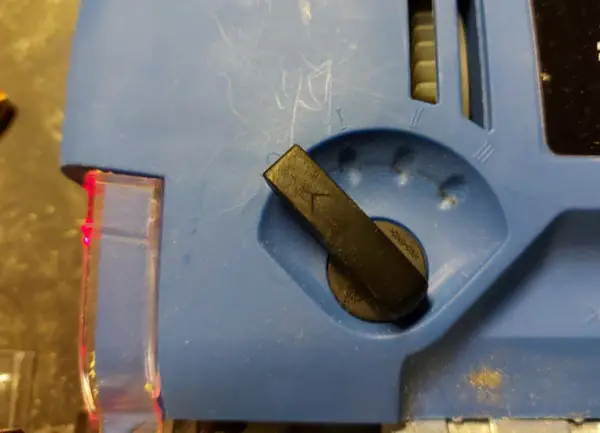
Most Jigsaws these days have several different settings. The most important setting when you need to know about when cutting a 2X4 is the orbital setting. The orbital setting adjusts how fast and aggressive the cut will be.
The orbital setting adjusts the angle of the blade when cutting. If it is set to max, the blade will cut in a circular motion while also going up and down. If the orbital setting is Off, the blade will just go up and down in a straight line.
The orbital setting is normally a lever on the side of the tool, like the one in the image above.
The orbital setting on a jigsaw usually starts at 0 (Off) and ends at 3.
Setting your orbital setting to 0 will result in a cleaner and less aggressive cut. It reduces the amount of tear on the wood, but it will take longer to achieve the cut.
Setting your orbital setting to 3 will result in a rougher but more aggressive cut. It increases the amount of tear on the wood and makes the jigsaw cut faster.
2. Choose The Right Blade (Size And TPI)
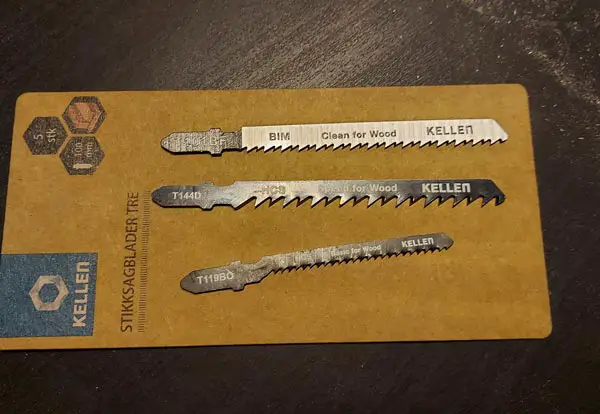
Choosing the right blade for a Jigsaw is quite simple. But choosing the right blade will be one of the most important choices you make to achieve the results you want.
For clean cuts, you want a blade with high TPI (Teeth Per Inch). 10 – 12 TPI is a good range when you want to do clean cuts with a Jigsaw.
For quick cuts, you want a blade with a lower TPI. 6 – 9 TPI is a good range when you want to do quick aggresive cuts.
The images below show you the different cuts when using a 6 TPI and a 12 TPI blade.
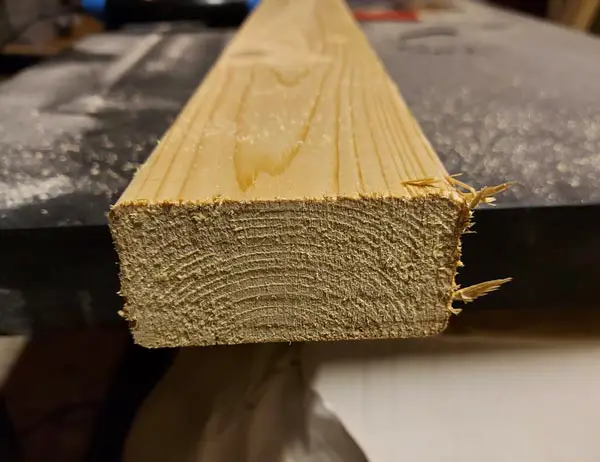
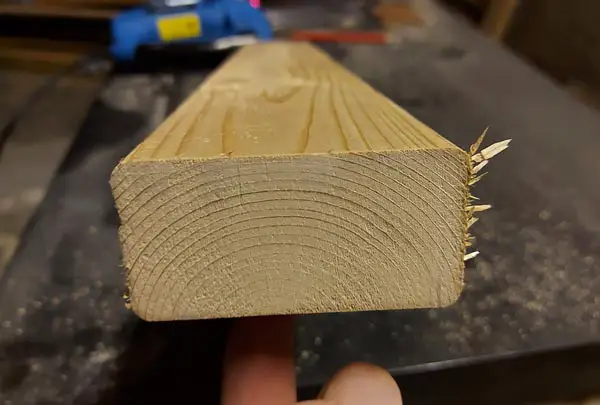
Using a higher TPI (Ex.12) blade for cutting something as large as a 2X4 will slow down the cutting significantly. This will also increase the chances of the blade warping while cutting. I personally never go above 10 TPI when cutting 2X4.
You also want to make sure that your blades are long enough to cut through a 2X4 in one pass.
The Jigsaw blade must be at least 3″ inches long to cut a 2X4.
It is possible to cut from both sides with a Jigsaw. But this will make the tool vibrate a lot when cutting, so it is hard to achieve a good quality cut this way.
I made a guide about Jigsaw blades if you want to read more:
3. Decide If You Want To Use A Guide Or Not
If you don’t care about the quality of the cut, you don’t have to use a guide. Just set your orbital setting to the max setting, use a blade for cutting wood with low TPI ( 6 – 8) and start cutting.
For example, if you are cutting old 2X4 studs into firewood. Then use the method above.
If you want to make a clean 90-degree cut with a jigsaw. You will have to use a guide of some sort.
However, making a clean 90 degree cut in 2X4 with a Jigsaw is extremely challenging, frustrating and close to impossible. But if a Jigsaw is what you have, you can come close to a clean 90 degree cut with some prepartion and practice. And it might just be good enough.
Here is the most important steps to take to cut a 2X4 to 90 Degrees With A Jigsaw:
- Use a quality Jigsaw ( Cheap tool = Frustration)
- Use a new sharp blade
- Use a blade from 6 – 10 TPI
- Do not force the cut
- Use a DIY guide rail to guide the cut
- Secure the 2X4
- Practice
There are many methods for guiding the cut. Experienced woodworkers can come close to 90-degree by just using a speed square as a guide, or by just following the marking.
I am not that skilled yet, so I like to measure, mark and secure the wood before doing the cut.
DIY Guide Rail For Jigsaw:
Mark The Cut – Make a line where you want to do the cut. Use a speed square to make a 90-degree line.
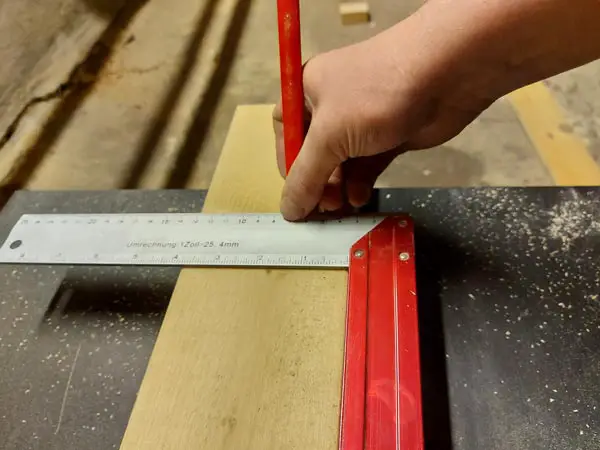
Measure Blade-to-Edge Distance – Measure the distance between the blade and the edge of the jigsaw. Make a second mark on the 2X4 at exactly the same distance.
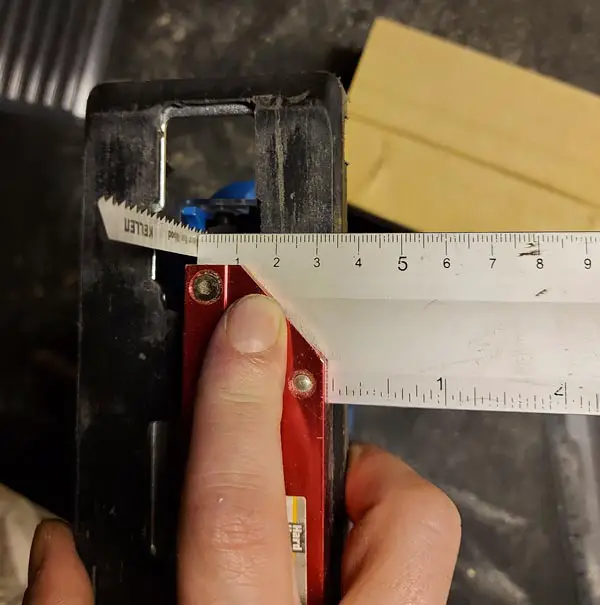
Use A Square Plank As A Fence – Use a squared plank to act as a guide rail. Clamp it down on the second line that we marked on the 2X4.
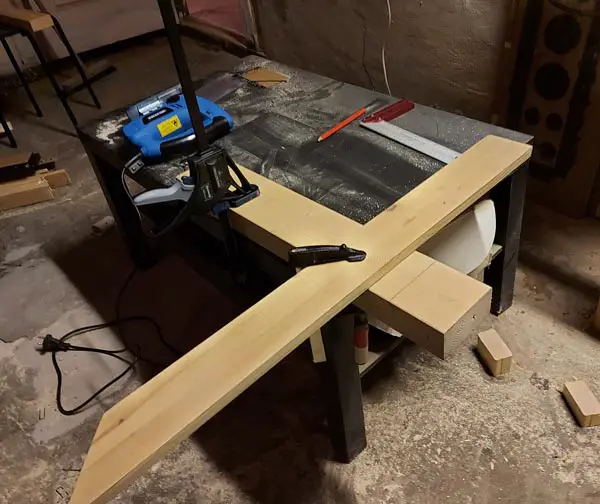
Now we have a fence that we can follow with our jigsaw while cutting, this will make it easier to make a clean cut.
4. Secure The 2X4
Before we start cutting we need to secure the 2X4.
When I need to make a quick cut without worrying about quality, I use a low table to secure the 2X4 with my body weight. I press the 2X4 down into the table with my knee and stabilize it with my left hand while controlling the Jigsaw with my right hand.
When cutting a 2X4 freehand this way you have to make sure that you are being safe and don’t take any risks. When cutting freehand the potential for human error is greater. You are in charge of your own safety.
You can also use a sawbuck to secure the 2X4, this is often used for cutting firewood.
If you are aiming to cut a clean 90-degree cut, I highly recommend securing the 2X4 properly. A good option is to secure with clamps to a flat surface, for example, a table.
Make sure that the marking on the 2X4 clears the table, so you do not cut into it.
5. Safety Gear
Protection Glasses – Always use eye protection when using power tools. You never know when a small piece of anything can come flying toward your eyes.
Dust Mask – Using the Jigsaw with finer blades will produce finer dust that can get into your airways. It’s often a good idea to use a dust mask when cutting anything with a Jigsaw.
Gloves – Gloves are optional. Gloves are usually not a good idea to wear around power tools in case they get caught in the tool while it is running. But in the case of Jigsaws, the gloves help to reduce some of the vibrations from the tool. But they are not necessary.
6 . Start The Cut
Now we are all set up. The safety gear is equipped, our 2X4 is secured the way we want it, and the settings and blade size are all set.
Before starting the Jigsaw we need to make sure that the cable is not in the way of the blade. This is actually a pretty common problem. If you have a battery powered jigsaw, then you have no cable to worry about.
Start the Jigsaw and rest the flat surface on the jigsaw onto the flat surface of the 2X4 without initiating the cut.
If you are using the guide we made before, make the jigsaw rests to that as well.
Slowly move the Jigsaw forward to initiate the cut.
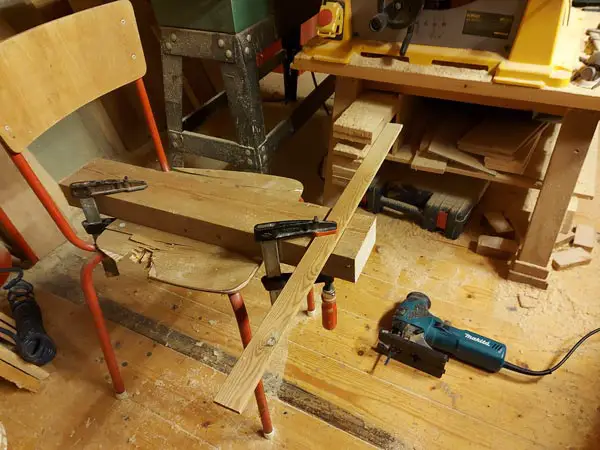
It is important to not use much force. Let the tool do the work and go slow. Especially if you are aiming for a high-quality cut with.
It is ok to force the tool a little bit if you are just rough cutting with a coarse blade.
7. Tips For Cutting With A Jigsaw
Using too much force will cause the blade to slide out and cut at an angle. Even if you follow the line. This makes for a very bad cut.
Using too much force over time can also make the blade overheat because of the friction. This will make the sawblade less durable and it will reduce its effectiveness while cutting.
A Jigsaw blade usually cuts on the upstroke. This means that the tearing in the wood is most visible on the face that you see when cutting.
Cover the surface of the cut with masking tape if you want to reduce tear in the wood as much as possible. But make sure to trace the cutting line after you have taped the surface.
Use a high quality jigsaw. If the motor of the jigsaw is not strong enough to cut the 2X4 properly and you have to force it through the cut, then the blade will definetly twist while cutting. The difference between a good quality jigsaw and a bad quality jigsaw is night and day.
8. Finishing Touches
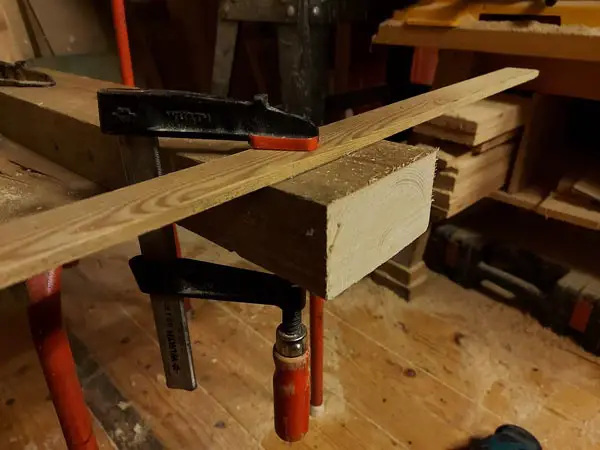
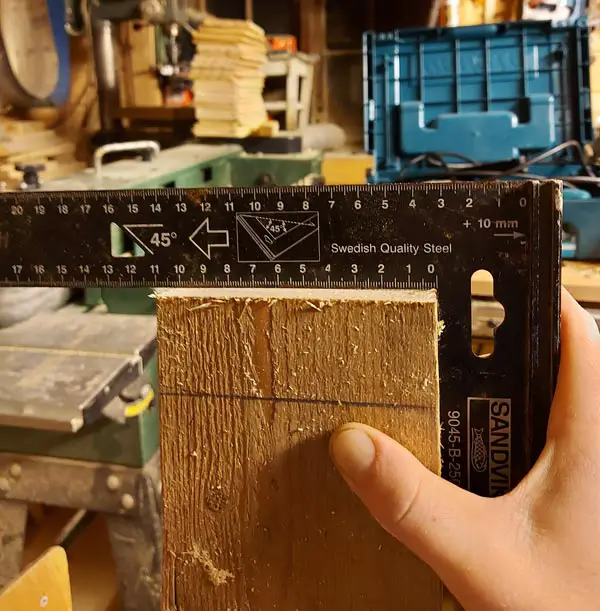
Well, that is about it. Above you can see the result achieved by using the methods in this article.
We get very close to a clean 90 degree cut with the Jigsaw, but it is not a perfect 90 degree cut.
There are so many different methods and techniques to learn when you want to get good at using a Jigsaw and this article is just barely scratching the surface.
But hopefully, it helped you with your mission to cut a 2X4 today.
